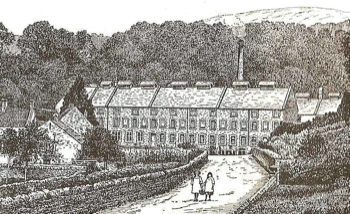Reference: [2] Handmade Paper in Tuckenhay Devon by Catherine Cox (1977)
|
The Beater Room. Despite the sorters and the magnet enemies to perfect papermaking may still lie hidden in the rags so once more they are overlooked and thrown into a bin. In the Beater Room the floor is on two levels - on the top half are the breakers and washers and in the lower half the beaters. A box known as the distributor has valves in it, which connect through pipes to a subterranean chamber, the Bleach house and also to chests in the Vat house. The breakers, washers and beaters are all oval lead lined containers within which are the mechanics of beating: the fly bars, bedplates, rolls and drums. Filling the breaker with rags and water the bladed barrel on one side of the breaker, churns round like a steamers' paddle wheel - these are the flybars, while on the other side a drum of brass wire sucks away the dirty water. The roll is put down carefully as the rags and the water revolve. This is to draw out the fibres - which gives the finished paper its body. Here in the breaker the rags are washed and bleached for half an hour, washed again, then let down into tanks in the bleach house, where this Half stuff, as it is known, stays in bleach for twenty four hours. |
The beds of the bleaching tanks have Delebole slates for drawing off the liquid. When drained the solid mass is forked on to trolleys and returned to the room. Again this is fed into the washer which revolves and thoroughly washes the half stuff for two hours. It is a principle of great papermaking that the less chemicals the better the pulp. Broken, bleached, washed and perfected, the stuff is now dropped into the beater. Here, the shortening of the fibres starts, when breaking starts the fibres are long. The fibres are cut between the edges of the flybars and the bedplate bars. Shortening progresses rapidly, but as the beating proceeds, the length of the fibres diminish more slowly. Temperature has an important effect on beating, prolonged beating will cause the stuff to heat. This brings a moan from the vat house as the vatman cannot keep the stuff wet. When the pulp is ready for testing the beaterman takes two hand bowls, scoops up a few ounces of the pulp, mixes it with pure water and then throws the liquid backwards from one bowl to the other. Pouring off the water, he adds fresh clean water, the pulp is now so diluted it needs the expert eye of the beaterman to see the tiny fragments. No scientific instruments were used at Tuckenhay before 1950. Tests have been made this way through the years, the information was always handed on from father to son. Satisfied the pulp is ready the beaterman opens one of the holes in the box, pulls the valve in the beater, and the pulp slowly empties into the box, it then passes through the pipes into the chests in the vat house. |
Reference: The Story of Handmade Paper (1924)

Wookey Hole Mill, Somerset